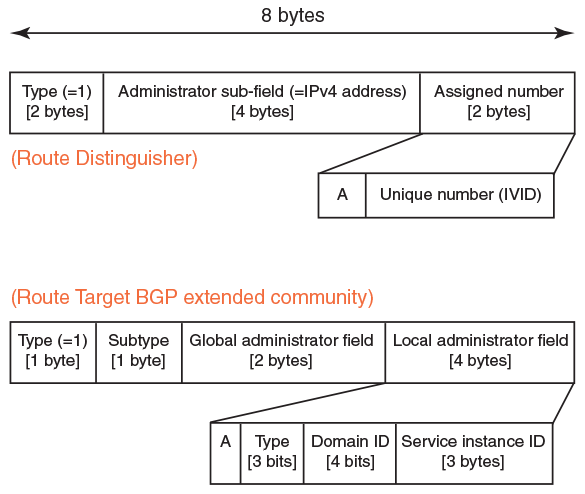BGP EVPN instance configuration
With a VLAN-based service model, each VLAN/BD corresponds to a unique EVPN instance, or MAC-VRF. Each route in EVPN belonging to a MAC-VRF has a unique route distinguisher (RD) that differentiates routes from other MAC-VRFs.
In addition, sets of route targets (export RTs) are associated with each MAC-VRF; these RTs are applied to the routes while advertising. RTs in the route are matched against the configured import RTs. If any of the RTs match, the route is imported; otherwise, it is discarded.

Note
Auto RD is mandatory for EVI extension with manual RD and RT/auto RT.Each VLAN/BD to be extended into an EVPN overlay must be added under the EVPN configuration block, as shown in the following configuration example.
evpn t1 ! vlan 1020 rd 1020:1 route-target both 1020:100 ! vlan 3200 rd 3200:1 route-target both 3200:100 ! bridge-domain 10 rd 10:1 route-target both 10:100 ! bridge-domain 3100 rd 3100:1 route-target both 3100:1
| VLAN/BD | EVI value |
|---|---|
| VLAN (1–4095) | VLANID |
| BD (1–4096+) | 4096 + BD-ID |
The EVID value in the preceding configuration example is not sent in the Ethernet-tag field in the routes. It is always 0 for VLAN-aware service. However, routes imported into the MAC-VRF table are classified against an EVID, which is shown in the Ethernet-tag field.
Autogeneration of route distinguisher and route target
Because thousands of VLANs/BDs can exist in the network, configuring each of them individually on each router is cumbersome. In order to simplify the configuration, Extreme recommends the autogeneration of RDs and RTs.
The RD of EVPN routes is encoded as a Type-1 route-distinguisher, as described in RFC4364. The following figure shows the formats of RD and BGP RT extended community.

The most significant bit "A" of the assigned number field stands for automatic or manual RD. For a manual RD value, this bit is set and the unique identifier value is set to the internal VLAN ID (IVID) to keep the RD unique across VLANs and bridge domain IDs (BD-IDs). The administrator subfield of the RD is set to the BGP router ID.
The global administrator field in the RT is set to the AS number. The local administrator field in the RT is expanded, as shown in the preceding figure. Bit-value "A" stands for automatic or manual RT. Where the RT value is derived automatically, this bit is set to 0. The service instance ID field carries the VLAN or VNI value. The Type field is set, according to the value set in the service instance ID space, to either 0 (= IVID) or 1 (= VNI). The domain-id value is not used currently and is set to 0.
RTs with the following service instance types are attached according to neighbor encapsulation:
| Neighbor encapsulation | RT service instance type |
|---|---|
| VXLAN | VXLAN (1) |
| MPLS | EVID (4) |
The configuration of VLANs/BDs that use autogenerated RD and RT values is simplified, as shown in the following configuration example.
evpn rd auto route-target both auto ignore-as vlan add 1000-2000 bridge-domain add 1000-2000
VLAN and bridge domains that are added with range, RD, and RT values are specified as "auto". In scenarios where multiple leaf nodes belong to different autonomous systems, Extreme recommends the "ignore-as" option. When that option is specified, the AS number field in the RT in the route is not compared against the local AS number.

